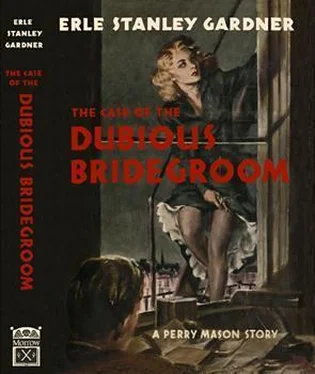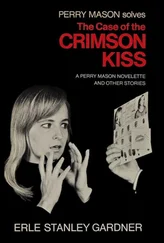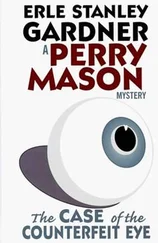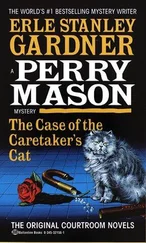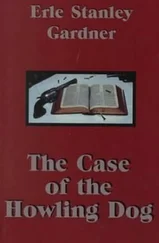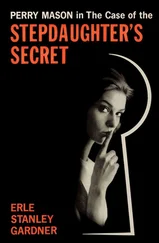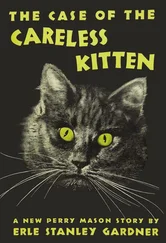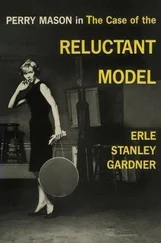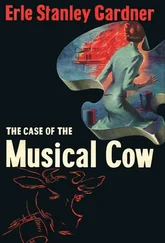“No, sir, they didn’t. There was just this one man there, but they contrived to have him walk around so I could see the way he walked, his gait, and his general build, and things of that sort.”
“By the way,” Mason said casually, “do you know what color clothes the man had on when you saw him leaving the booth? Was it a brown suit?”
“Sort of a brown, I think, yes, sir.”
“What color shoes?”
“Dark, I think.”
“And his necktie?”
“His necktie was... let me see. No, I never saw his necktie.”
“You don’t know whether he had a necktie on or not?”
“No, sir.”
“Why not?”
“Because I never had a front view of this man.”
“You didn’t see his features then?”
“No, sir.”
“Was he wearing a hat?”
“I... I can’t remember.”
“You don’t remember whether this man was wearing a hat?” Mason asked.
“No, sir.”
“You know what color socks he had on?”
“No, sir,” Scanlon said, smiling.
“Or the color of his shirt?”
“It was... I think it was... No, sir, I don’t know.”
“So,” Mason said, “you are identifying a man whom you saw with one eye through a crack in the door in a dark lobby, a man whose face you had never seen in your life until the police pointed him out to you in the jail and...”
“No, sir, that’s not right. I pointed him out to the police.”
“In the jail?”
“Yes, sir.”
“You were with the police at the time?”
“Yes, sir.”
“How many other prisoners were in sight?”
“Just this one. There were no others in the place where I saw this man.”
“And yet you say the police didn’t point him out to you?” Mason asked sarcastically. “They did tell you they were going to show you a man they wanted you to identify, didn’t they?”
“Well, they said they’d like to have to look at this man and see if I could, identify him.”
“And then this one man was brought in to the yard or shadow box or whatever place it was where you were given an opportunity to look at him?”
“Yes, sir.”
“And do you mean to tell me that one of the police officers didn’t say to you at that time in effect, ‘There he is. Take a good look at him. Look at the way he walks. Look at him when his back’s turned’?”
“Well, yes, they did say something like that.”
“And you identified this man before the officer said that?”
“No, sir,” Scanlon said. “It was afterwards.”
“How long afterwards?”
“After he’d walked around for a little while.”
“I see. Just as soon as the officer told you that he wanted you to identify this man you pointed your finger and said, ‘That’s the man,’ didn’t you?”
“No, sir, I didn’t. I looked him over a good long while before I identified him.”
“A long while,” Mason said scornfully, “ten or fifteen or twenty seconds, I presume.”
“No, sir,” Scanlon insisted, “it was a minute or two.”
“As much as two minutes?” Mason asked.
“Yes, I’m certain it was.”
“Could it have been longer than that?”
“It could have been.”
“As much as three minutes?”
“I’ll say it could have been. I think perhaps it was. I wanted to be sure.”
“In other words,” Mason said, “it took you three minutes of careful study of this defendant under conditions of good visibility to make up your mind that he was the man.”
“Well, it could have been three minutes.”
“Now, when you saw this man whom you observed in Tijuana that night,” Mason said, “you saw him after he had left the telephone booth and while he was walking across the lobby?”
“Yes, sir.”
“How fast was he walking? Was he moving rather rapidly?”
“Well, he was walking right along.”
“And you didn’t see him until after he had passed a few feet from the telephone booth?”
“Yes, I guess so.”
“Ten feet?” Mason asked.
“Perhaps.”
“And you couldn’t see him after he had passed through the outer door and gone out into the yard where the cars were parked?”
“No, sir.”
“Now, how many feet is it across that lobby?”
“Oh, I’d say it was perhaps twenty-five feet.”
“So you only saw this man while he was walking rather rapidly for a distance of fifteen feet?”
“Yes, sir.”
“And you observed him with one eye?”
“Yes, sir.”
“In semi-darkness.”
“Yes, sir.”
“With his back turned toward you.”
“Yes, sir.”
“And that’s why it was so difficult for you to be absolutely certain when you made your subsequent identification, wasn’t it?”
“What do you mean?”
Mason said, “That’s why you studied the matter for some three minutes before you were able subsequently to identify this man and say to the officers, ‘Yes, that’s the man.’ ”
“Yes, sir, that’s right.”
“Now, how long do you suppose it took that man to walk the fifteen feet?” Mason asked.
“I don’t know. I hadn’t figured it. A little while.”
“Do you know how many miles an hour a man covers at an ordinary walk?”
“Well, if you want to put it in miles an hour,” Scanlon said, “while he was going that fifteen feet I’d say he was walking — oh probably three miles an hour.”
“All right,” Mason said, “let’s do a little mathematical computation.”
He whipped a small slide rule from his pocket, manipulated it quickly, said, “For your information, Mr. Scanlon, a person walking one mile an hour covers about .46 feet per second, so at the rate of three miles an hour that man would cover approximately 4.4 feet per second.”
“I’ll take your word for it,” Scanlon said, smiling.
Mason said, “So in walking fifteen feet at the rate of speed you mention, the man would have covered the distance in something less than three and one-half seconds. Therefore, unless you are mistaken, you saw this individual for approximately three and one-half seconds with one eye under conditions of dim light.”
“Well, I guess that’s right if you say so.”
“I’m simply making the necessary mathematical computations from what you yourself have told me.”
“Yes, sir.”
“And you now think that’s right, do you, Mr. Scanlon, that you saw this man for about three and a half seconds?”
“Well, I thought it was longer than that but if that’s the way it figures out why I guess that’s right.”
“Saw him three and a half seconds under conditions of very poor visibility with one eye, looking at his back,” Mason said, “but when you wanted to identify him for the police, when you wanted to be sure, it took you three minutes under conditions of broad daylight looking at him where you could see his face, his figure and everything about him?”
“Well, I wanted to be sure.”
“So in order to be sure of the man’s identity you had to look at him for three minutes with both eyes and in full daylight?”
“Well, to be absolutely certain.”
“Then,” Mason said, with a friendly, disarming smile, “when you saw him under conditions of poor visibility for only three and a half seconds looking at him with only one eye, you naturally weren’t absolutely certain of his identity, were you? Not at that time, at the end of the three-and-a-half-second interval?”
“No, I wasn’t certain of it then,” Scanlon conceded, “not absolutely. But I was after I saw him there in the jail.”
“I thought so,” Mason said, with a smile. “Thank you, Mr. Scanlon, that’s all.”
“That’s all,” Covington snapped angrily.
Читать дальше
